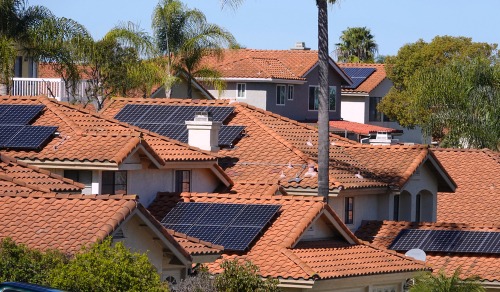California electric utilities unveil plan to even out consumer solar costs

California’s three major electric utility companies this week proposed a new compensation plan for future residential rooftop solar customers that will shift costs away from non-solar customers.
The proposal was filed March 15 with the California Public Utilities Commission by Southern California Edison, Pacific Gas and Electric Company and San Diego Gas & Electric Company. It is aimed at relieving non-solar customers of the cost of maintaining the state’s power grid for the benefit of solar-equipped homeowners who receive a generous credit for their excess power, which they place on the grid.
“The heart of this modernization effort addresses an unfair and growing inequity stemming from earlier versions of the rooftop solar Net Energy Metering (NEM) program,” the companies said in a written statement. “This cost shift leads to electricity customers without solar systems paying about $3 billion more annually in their electricity bills to subsidize existing rooftop solar customers.”
The companies said the change is a necessary fix for the state’s rooftop solar strategy, which was launched 25 years ago at a time when solar power was just getting off the ground and the cost of equipment was higher. “The subsidy represents the costs of the electric grid that solar customers use, but for which they do not pay,” the statement said. “Oftentimes, those left paying these higher costs are lower-income customers.”
The NEM program was due for changes, the companies said, because it had actually worked as expected when it debuted in the 1990s. Solar has grown from around 10,000 California homes to more than 1 million statewide while the cost of a rooftop system has fallen around 70 percent. As a result, more utility customers with solar are enjoying the benefits while non-solar customers are still ponying up an equal share of the cost of operating the grid.
The current credit that rooftop solar customers receive for excess energy sent to the grid is 25 cents per kilowatt-hour on average, the companies said, while the cost of electricity that they purchase from large-scale solar producers is 3 cents per kilowatt-hour.
The joint proposal would apply to future, new rooftop solar customers and not current solar customers. The plan calls for updating compensation for excess energy created by rooftop solar systems and exported to the grid to better align with the actual value of power and to be similar to what utilities pay for large-scale renewable energy resources.
Solar customers would also find a new surcharge on their bills to pay for the operation and maintenance of the grid.
“Customers are able to pay for their system in less than five years, but they continue to receive this subsidy for 20 years,” the companies said. “The result of this high credit is that rooftop solar customers do not pay their full share for use of the grid that they rely on or for state-mandated, public policy programs that support energy efficiency or lower-income customers.”
In addition, the plan would offer incentives to help get low-income residents set up for solar and encourage the installation of residential batteries that will store their excess energy for use at night.
The solar industry countered by saying the NEM program was critical to advancing the adoption of solar and had a key advantage in that it enables solar producers to “share” the electricity they produce with their neighbors. The Solar Rights Alliance said in an open letter to Gov. Gavin Newsom that such neighborhood microgrids would actually reduce stress on the grid by lessening the load demand during California’s frequent hot spells.
The Alliance, which includes various solar and climate advocacy groups, said the three utilities were discouraging the expansion of rooftop solar in general. “Net metering lets people use the sun for their energy needs and share the extra with their neighbors for a bill credit,” the statement said. “It should be strengthened, not weakened.”
